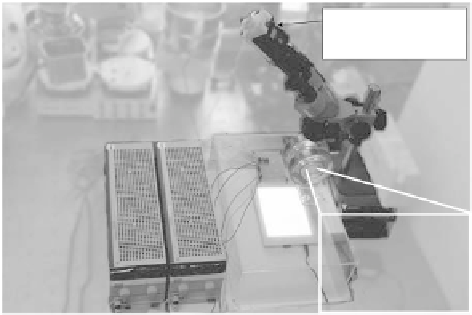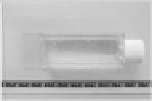Biomedical Engineering Reference
In-Depth Information
fructose with magnetic powders is emulsiied into 50
mL mineral
oil at 120
°
C under stirring. The suspension is cooled down rapidly
using an ice-bath with effective stirring to solidify MSPs separately.
Solidiied MSPs are washed in hexane to remove mineral oil and
surfactant completely. The diameter of MSPs is controlled between
the different mesh sizes of two sieves in hexane.
In order to prove the feasibility of proposed method, a magnetic
motion control system for MSP is developed as shown in Fig. 8.35(a).
Experiments of motion control are conducted in a well chamber
(Figure 8.35(a)) CCD camera (PRO5, RF System Lab., Japan) and
stereoscope (L-50, Hozan Co., Japan) collaborate to record the whole
motion process, and speciic software is developed for input current
control and image analysis [50]. The system can generate controllable
gradient magnetic ield at the axial direction of well chamber with
the work area of 40
mm
×
35
mm, and realize a resolution of 1
μm in
position capture, and with a vision scope of 20
mm in diameter.
Camera for MSP
Motion Capture
Human
Interface
Stereoscope
Stereoscopic
Image of MSP
Power
Source
b)
Chamber's Top View
Light
Source
a)
Figure 8.35
(a) Magnetic motion control system for MSP, working at room
temperature; (b) Top view of well chamber with the length,
width and height of 50
mm, 20
mm, and 20
mm, respectively,
the chamber is illed with hexane and MSPs are injected for
motion evaluation experiment.
Patterned scaffold is important for achieving different morphology
of tissues after cell cultivation. A conventional patterning device,
comprising poly(methyl methacrylate) (PMMA) with a thickness of
5
mm, and a interval of
3
mm, is utilized to generate dot pattern of magnetic ield on the
surface.
mm and steel wires with a diameter of 0.7

























































Search WWH ::

Custom Search